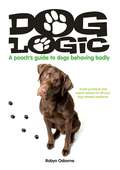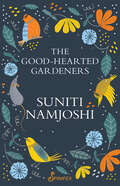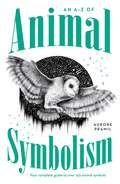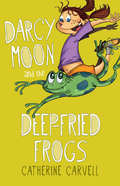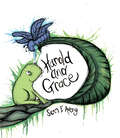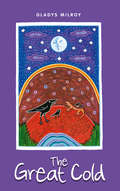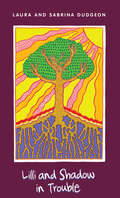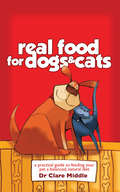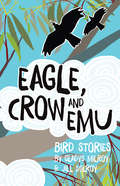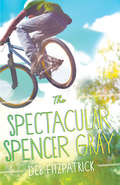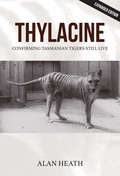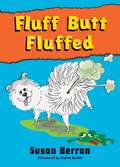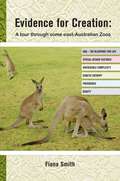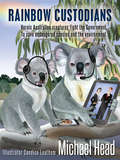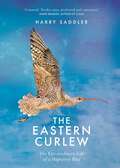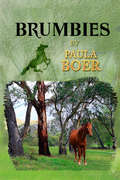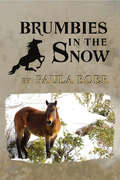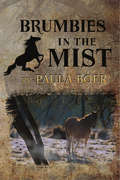- Table View
- List View
Dog Logic: A Pooch's Guide to Dogs Behaving Badly (Big Sky Publishing Ser.)
by Robyn OsborneKeen to turn your disobedient dog into the perfect pooch? Tired of man's best friend ending up in the doghouse? Why not take an informative and entertaining walk on the wild side, with Dog Logic, a unique view of the world, one that is both canine created and related. Whether your best friend is a blue blood or a bitser, Dog Logic has them licked. Should you let sleeping dogs lie, exactly who is top dog and can you teach old dogs new tricks? Dog Logic helps get you on the right scent and ensures you're not barking up the wrong tree. And who better to take you on a journey deep into the canine world, but a member of the pack himself; Sox, the quintessential Aussie cattle dog and four legged philosopher. With 20 chapters covering issues from barking, beds and biting, to worrisome walks and everything in between, Sox offers his humorous but practical advice on resolving your doggy dilemmas. Supported with terrific tips from humans in the know, each chapter provides both canine and two legged advice that is fun, uplifting and relevant. As a RSPCA puppy who overcame a difficult start to life, Sox is proof that a dog from the wrong side of the pound can achieve greatness. As the creative canine consultant to Dog Logic, Sox is no stranger to fame having written a regular full page column in bark! Australia magazine. Combining the creative genius of Sox the Philosophical Pooch, and his human assistant, Robyn Osborne, Dog Logic is the must have book for anyone searching for the ideal canine companion.
Hairy Nose, Itchy Butt
by Garry Duncan Elizabeth FrankelEver had an itch you couldn't scratch? Hairy-Nosed Wombat has one, and somebody has chopped down his favourite scratching tree! Join our marsupial hero on an itchity, scratchity adventure as he tries to find the perfect place to scratch his butt. Itchity, scratchity, grumble and groan. A shudder and shake, a snort and a moan. A grunt and a huff, and a spitterly splut. He said "I really need to scratch my butt." This story, written by South Australian author Elizabeth Frankel, and illustrated by Garry Duncan, will charm children and adults alike.
The Good-Hearted Gardeners
by Suniti NamjoshiWhat do you do when you fall in love with your next-door neighbour? You peer at each other through a hole in the fence and eventually climb over.Sybil is a member of The Good-Hearted Gardeners, a Society for Well-Meaning Efforts for the Betterment of Language and the Salvation of the Planet, which her lover, Demo, is allowed to join. It' s funded by MI5, who ask them to monetise and weaponise the English language. Soon afterwards they discover that English is even more widespread than anyone had thought. Even the birds and the fish, the cows and the kangaroos can speak it – when they choose. The Good-Hearted Gardeners set about trying to talk to anyone – crows, magpies, robins, goldfish, cows, horses, rats, mice – who will talk to them.With climate change and technology gone mad, what' s in store is a frightening scenario that threatens everyone – humans, animals, plants. Can the headlong rush to extinction be halted?When the birds, and the cows and the horses and the mice and all the rest come together, much is made possible. But at what cost? Will the planet and its inhabitants be saved? A comedic allegory for our future.
An A-Z of Animal Symbolism: Your complete guide to over 150 animal symbols
by Aurore PramilLearn to interpret the messages the animal world has for you!A bird knocks insistently on your window, your cat brings you a lizard, you find yourself face to face with a spider or you dream of an elephant ... what if each animal had a message for you? Animals have always been a source of fascination for humans - we love to watch them, learn about them and keep them as pets. But what if animals could actually communicate with us? In this complete guide, you'll find everything you need to know about the symbolism and signs of more than 150 animals, whether they appear to you in a dream or 'happen' to cross your path. You'll learn their individual characteristics as well as the elements and seasons they're associated with. You'll also discover what these encounters mean for different aspects of your life including love, career, family and health. Messages from the animal world are always filled with compassion but animals aren't there to flatter your ego. Rather, they aim to help you advance in consciousness in your life's journey. Sometimes you'll receive an encouraging sign that confirms you're on the right path or guidance to help you move forward. Other times, an animal will deliver a deeper lesson for you to explore, because that's how we learn. More than anything, their messages can open avenues of questioning and help to make your way forward clearer. The animals wish you well; they want you to hear their messages. Let them become your guides!
Darcy Moon and the Deep-Fried Frogs
by Catherine Carvell Michael Scott ParkinsonDarcy Moon is an ordinary girl with ordinary problems. She’s low on cash and low on the necessary street cred to fit in with the cool crowd. But Darcy’s life is about to take a great leap forward. When a freaked-out frog asks for help, it’s up to her to fix the food chain, save the swamp and prove that money can’t buy everything. This slimy adventure story is an enjoyable romp with environmental themes.
Harold and Grace
by Sean E. AveryA sweet picture book with a different take on metamorphosis and a surprising ending Two tiny eggs, one in a pond and one on a tree, survive a brutal storm and hatch at the same time. Harold is a tadpole and Grace is a caterpillar. Neither of them can find similar creatures, and they are mocked and ridiculed by those around them until they find each other and become friends. But as they grow, they grow apart. Harold explores further in the pond and leaves Grace behind on her tree. Harold's new friends, the fish, think he's great until he starts growing legs, then they turn on him. Sad and dispirited, Harold returns to find Grace but she is nowhere to be seen; in her place is just a hard little chrysalis. Harold mourns for Grace and keeps vigil over the chrysalis. One morning Harold wakes to something fluttering in the dim light. Hungry, he flicks out his tongue and grabs it, but the fluttering is no meal, it is Grace, hatched at last and now a beautiful butterfly. Back together again they remain true friends and live happily ever after.
The Great Cold
by Sally Morgan Gladys Milroy Tracey GibbsAs the great cold moves in and creeps into their hideaways, the animals are forced to prepare for winter. The blind goanna lizard and the flightless magpie—the weakest among the animals—are helpless on their own, but when they work together, the power of their friendship and cooperation make them strong enough to survive the elements. Told in the traditional style of indigenous Australians, this original story enlightens young readers with a message of reconciliation and promotes care for the environment.
Lilli and Shadow in Trouble
by Laura Dudgeon Sabrina DudgeonThis is the second book to follow the adventures of Lilli—a young girl who has moved from the Australian bush to the city—and her magical animal friend, Shadow. While on holiday visiting family in the bush, Lilli discovers that Shadow is fading. Someone, or something, has taken over Shadow’s home in the old mango tree and Shadow is scared. With Lilli’s help, and with some assistance from Nan, they find the best solution for everyone, including the mango tree creature. Inspired by the art of Aboriginal storytelling, this charming read is sure to entertain junior readers.
Real Food for Dogs & Cats
by Dr Clare MiddleFor every pet lover who wants to ensure their cat or dog has the best chance of a long and healthy life, this no-nonsense guide to natural and balanced pet nutrition has simple, practical, and effective ways to keep pets in top condition. Combining a wealth of experience with sound science in this easy-to-use book, this book is a must for all pet owners, breeders, veterinarians, and animal health professionals wanting to feed dogs and cats the natural way.
Eagle, Crow and Emu: Bird Stories
by Gladys MilroyThree fantastic stories by Indigenous mother-and-daughter team Gladys and Jill Milroy, collected together for the first time. Told in the tradition of teaching stories, these avian tales take young readers on adventures of self-discovery and fulfilment with endearing animal characters and exciting plot lines.
The Spectacular Spencer Gray
by Deb FitzpatrickSpencer Gray is just an ordinary kid, but he manages to get in to some pretty extraordinary situations. Playing soccer at school with his mates he accidentally uncovers a sinister animal smuggling operation and rescues a super-endangered potoroo. But when the smugglers discover him trying to release the potoroo, he risks becoming super-endangered himself. Trussed up and left in the bush, he needs to use all his inner strength and ingenuity to break free and get help. With good friends and a great family to back him up, Spencer manages to triumph in the end. A page-turning adventure story for middle readers.
Thylacine
by Alan HeathThis book details how, in November 1993, during a holiday in northern Queensland, the author was first told by a witness to a Thylacine (Tasmanian Tiger), on Cape York Peninsula. It also details some of the many other Thylacine sightings on mainland Australia and in Tasmania that he has been told about up until 2014. The author wrote this book at the suggestion of an academic working at a Queensland university, after the author told the academic about some of the Thylacine sightings that he had been told about in Queensland.
Fluff Butt Fluffed
by Susan BerranThe Fluff Butt series for early readers (4 – 6 years) are lovely little books that follow the adventures of Fluff Butt the farting dog. Fun and just a little gross, Fluff Butt’s escapades are sure to make young readers smile and grimace along the way. The first of the Fluff Butt series ‘FLUFFED’ introduces this playful and smelly- bottomed little puppy and the rest of her interesting family. Fluff Butt is hanging out at home where his stinky rear-end has him in all sorts of trouble with his family. Could it get any worse? Only if they take him to school...
Dogs: Fun Facts and Amazing Stories (Awesome Animals #1)
by Dianne BatesDogs really are the perfect best friend. They are loyal, smart, fun and totally awesome! In this fabulous combination of remarkable true stories, amazing facts and lots of fun stuff, we get to discover just how incredible our canine friends really are. From stories about dogs in history, heroic dogs and working dogs to bizarre facts and wacky dog jokes, this book will entertain and make you smile. This gorgeous book also features lots of beautiful illustrations and images of the adorable dogs from Best Friends Pet Rescue.
Cats: Fun Facts and Amazing Stories (Awesome Animals #2)
by Dianne BatesCats are more than just cute and cuddly pets. They are playful, clever, mysterious and totally awesome! Packed full of incredible true stories, fascinating facts and lots of fun stuff, this books shows just how remarkable our feline friends really are. From stories about cat adventurers, famous cats and spoilt cats to bizarre facts and wacky cat jokes, this book will entertain and make you smile. This gorgeous book also features lots of beautiful illustrations and images of the adorable cats and kittens from Little Legs Pet Rescue
Evidence for Creation
by Fiona SmithThis book focuses on specific design features of many Australian, and other, animals as well as other evidence for intentional creation by a Creator.It is intended as an aid when visiting east-Australian zoos, as well as a study manual for biology students, at a level of academic rigour expected in high school (or above) science.With its clear apologetic for creation, it is meant as a counter to the plethora of academic biology books and documentaries that extol evolution by random chance and time. In the book, the reader will be introduced to many standard biological terms used at the middle and upper high school level. These have all been well defined. There is also a Glossary at the back to help revise any new terms. The book is sectioned by animals (in alphabetical order) and apologetics. At the end of each section there are Review Questions to re-enforce learning for the student or enquiring adult. Answers to these appear at the back. The book also contains many colour photographs of the animals described.
Rainbow Custodians
by Candice Leathem Michael HeadThe narrative Rainbow Custodians describes the incredible efforts of creatures to rise against the environmental destruction caused since the European invasion of Australia. The central characters Bert and Bennie Koala rally all manner of wildlife to jolt humans into growing a conscience and acting to save endangered creatures and the environment. Rainbow Custodians is designed to link to school curriculum and focuses on important issues such as indigenous people's relationship to land, creation, spiritual connection to mother earth and custodianship. The text exposes environmental degradation, human apathy towards extinct and endangered species and sustainability. Cultural inclusion, sustainability and right relationship are further topics that can be used to enhance the application of this book. Australian wildlife is proudly paraded throughout to familiarise the reader with our unique and wonderful creatures. Poetry is woven throughout the text to enchant the audience with this tale of perplexing complications, intelligent solutions and climactic inspirational codas. The text assumes a life of its own through the brilliant illustrations of Candice Leathem that adorn the cover and each of the ten chapters. These images are designed to delight viewers, provoke discussion and are superb teaching tools. The intended audience ranges from middle - upper primary to early secondary levels, as the text relates to key concepts explored within educational curriculum, but it also has inherent appeal for an older audience. The issues explored within this book have global appeal and it is hoped that a wider audience may enjoy this text and learn from the experience. Thank you for taking the time to read Rainbow Custodians.
The Power of Ruby's Words
by Susie Berryman Katherine May WattRuby is a Shrew and Muriel is a Marsupial Mouse and they are very good friends. They caught the bus to the beach and Muriel brought her happiness. Ruby did not! Muriel knows the secret. Can Ruby find the secret too?
Sky
by Ondine ShermanAfter her mother’s death, Sky is forced to leave her city life behind and move in with her aunt and uncle in a small Australian town. But the city isn’t all that she leaves behind. Trying to fit in with her new friends means doing things she never dreamt she’d do. And falling for the School Queen’s crush is the least of her worries when she’s confronted by tightly guarded family secrets. Just as she thinks everything is starting to feel normal, Sky stumbles on a case of animal cruelty that forces her to make some tough decisions. Will Sky risk everything to stand up for what she believes in? Sometimes you have to lose everything to find yourself.
Balthazar’s Crystal: A Magical Adventure with Royal Bears
by Anne WarneBalthazar's Crystal is magical and through its power we go on journeys to countries we may know little about and are asked to think about some big questions; questions like: How do we treat bears, one of our largest mammals? Why are they becoming endangered? Could we use land on our shared planet to make the world a better place for humans and animals? Should large animals such as bears be kept in zoos? These are huge questions and there are no easy or quick answers but they are questions that should at least be asked. To help us think about questions like these we journey with Balthazar (his nickname's Zar), his brother Zachary (or Zach for short) and their young friend Tae to the home of the Royal Clan of Bears from the country of Bhutan, to Far East Russia and to other places in our amazing planet. Through the power of Balthazar's Crystal we also Time Travel to learn some of the history of bears and humans in an effort to gain greater understanding of how humans and large animals interact on a planet that is seeing more and more natural habitats disappearing. Our journey begins when Zach sees a cloud in the exact shape of a bear and when he tells Zar they both have a sense of knowing that awakens in them all sorts of feelings - feelings of excitement, anxiety, hope and also courage and sorrow. Then when a man bumps into Zar and tells him urgently to go to the Crystal Shoppe not far away he realises that an adventure is about to begin for he and his brother. The brothers are joined by their friend Tae and as they enter the Crystal Shoppe they are greeted by the man who had just earlier bumped into Zar. He introduces himself as Ursus and he also introduces his brother Bhu, informing the boys that he is actually a bear who can transform into a human when required. Zar, Zach and Tae are asked by Ursus and Bhu to journey with them on the Path of Remembering to learn more about the history of bear and human interactions and that is when Balthazar's Crystal appears, glimmering and glinting, wielding its magic to lift boys and bear-men into the vortex of air created by its power and into the first stage of the Path of Remembering.
Soldier's Best Friend
by Stephen Paul StewartMilitary working dogs are silently winning the war against the world's deadliest insurgents; day after day saving soldiers' lives in the most dangerous countries on the planet. Many have been rescue animals, neglected or mistreated by their owners before being given a new lease of life on the front line. From the featureless plains of Helmand and Kandahar to military bases in Germany, army dog teams work day and night to keep us safe but, until recently, their courage and sacrifice has not been fully understood or appreciated. Award-winning journalist Stephen Paul Stewart employs in-depth interviews together with years of research and frontline reportage to tell their gripping and emotional stories for the first time. 'A fascinating insight into a little-known subject, A Soldier's Best Friend is a moving and engrossing read.' -- Niall Edworthy
The Eastern Curlew
by Harry SadlerEvery year around August, large flocks of Eastern Curlews leave their breeding grounds in the Arctic and embark on a perilous 10,000km journey to the coast of Australia. The birds cannot swim; if they become exhausted and fall into the ocean, they die. But it?s a journey they have taken for tens of thousands of years, tracing invisible flyways in the sky in what is one of the most spectacular mass migrations in the animal kingdom. Following the Eastern Curlew along its migratory path, award-winning nature writer Harry Saddler explores how these incredible birds have impressed themselves on the cultures of the countries they fly through, the threat to their survival posed by development, and the remarkable ways these birds and humankind may be entwined. The Eastern Curlew is a delightful and vivid portrait of a fascinating natural phenomenon.
Brumbies (Brumbies #1)
by Paula BoerWhen city girl Louise moves to the country, she discovers the mountain brumbies are to be killed for pet food. She and Ben, a local farm boy, determine to save as many of the wild horses as they can. Despite opposition, they arrange a muster, but nothing goes according to plan. Following in the hoof-prints of "The Silver Brumby" and "The Man from Snowy River", this horse-packed adventure encounters challenges through some of the toughest territory in Australia.
Brumbies in the Snow (Brumbies #2)
by Paula BoerTaming a wild horse is no easy task, as Ben and Louise soon discover. Their progress is slowed by a runaway horse and a desperate search through the park for two lost hikers. Concern for an injured brumby adds to the complications. Follow the wild twists and turns of the Best Selling sequel Brumbies adventure, as Ben and Louise explore the High Country of Australia in winter and learn what it means to break in a brumby.
Brumbies in the Mist (Brumbies #3)
by Paula BoerThawing snow threatens Crowhurst with flooding and the wild horses are missing from the mountains. As the community struggles to protect their homes, disaster strikes for the Naylors. Ben and Louise are separated, and are each trying to take care of their own brumby's troubles. The disappearance of the herds remains a mystery until the friends make a worrying discovery.
